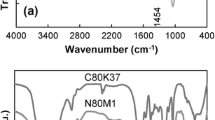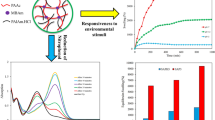Abstract
Nanocomposite hydrogels were prepared by cross-linking of aqueous solutions of sulfonated polyacrylamide/sodium montmorillonite with chromium triacetate as ionic cross-linker. The effect of montmorillonite content on equilibrium swelling in NaCl and CaCl2 solutions, ultimate storage modulus and effective cross-link density was evaluated. The limiting storage modulus of the nanocomposite (NC) hydrogels dropped by increasing montmorillonite content up to 1,000 ppm, and then it increased by further montmorillonite loading. A mechanism is proposed for the formation of PAMPS/Na+-MMT/Cr3+ NC hydrogels. According to this mechanism, the drop in limiting storage modulus of the NC gels at low Na+-MMT concentration is due to ionic interactions between the negative layers of sodium montmorillonite and Cr3+, leading to decreased cross-link density. However, the increase of the limiting storage modulus of the NC gels at high clay concentration results from the strong interactions between the polyacrylamide chains and clay platelets. The equilibrium swelling ratio of the NC networks decreased with increase of montmorillonite content in both aqueous NaCl and CaCl2 solutions. In addition, the experimental swelling data of these NC hydrogels were described by a modified Flory–Rehner theory. The modified model was sensitive to montmorillonite concentration and it described adequately the swelling data for NC gels in NaCl solutions. Nevertheless, theoretical predictions showed some deviations from experimental results for swelling of NC hydrogels in CaCl2 solutions.








Similar content being viewed by others
References
Zhou C, Wu Q (2011) A novel polyacrylamide nanocomposite hydrogel reinforced with natural chitosan nanofibers. Colloid Surf B Biointerfaces 84:155–162
Hibino T (2010) New nanocomposite hydrogels containing layered double hydroxide. Appl Clay Sci 50:282–287
Zhang Q, Li X, Zhao Y, Chen L (2009) Preparation and performance of nanocomposite hydrogels based on different clay. Appl Clay Sci 46:346–350
Haraguchi K, Takehisa T, Fan S (2002) Effects of clay content on the properties of nanocomposite hydrogels composed of poly(N-isopropylacrylamide) and clay. Macromolecules 35:10162–10171
Shibayama M, Suda J, Karino T, Okabe S, Takehisa T, Haraguchi K (2004) Structure and dynamics of poly(N-isopropylacrylamide)-clay nanocomposite gels. Macromolecules 37:9606–9612
Ganji F, Vasheghani-Farahani S, Vasheghani-Farahani E (2010) Theoretical description of hydrogel swelling: a review. Iran Polym J 19:375–398
Gundogan N, Melekaslan D, Okay O (2003) Non-Gaussian elasticity of swollen poly(N-isopropylacrylamide) gels at high charge densities. Eur Polym J 39:2209–2216
Flory PJ (1953) Principles of polymer chemistry. Cornell University Press, Ithaca
Flory PJ, Rehner J (1943) Statistical mechanics of cross-linked polymer networks. II. Swelling. J Chem Phys 11:521–526
Dusek K, Patterson D (1968) Transition in swollen polymer networks induced by intramolecular condensation. J Polym Sci Part A-2 Polym Phys 6:1209–1216
Sen M, Guven O (2000) Prediction of the swelling behavior of amphiphilic hydrogels and the determination of average molecular weight between cross-links. Comput Theo Polym Sci 11:475–482
Brannon-Peppas L, Peppas NA (1991) Equilibrium swelling behavior of pH-sensitive hydrogels. Chem Eng Sci 46:715–722
Katchalsky A, Lifson S, Eisenberg H (1951) Equation of swelling for polyelectrolyte gels. J Polym Sci 7:571–574
Ricka J, Tanaka T (1984) Swelling of ionic gels: quantitative performance of the Donnan theory. Macromolecules 17:2916–2921
Khare AR, Peppas NA (1991) The structure and transport properties of environmentally sensitive hydrogels. Polym News 16:230–236
Okay O, Sariisik SB (2000) Swelling behavior of poly(acrylamide-co-sodium acrylate) hydrogels in aqueous salt solutions: theory versus experiments. Eur Polym J 36:393–399
Paxton RA, Al-Jumaily AM (2006) Swelling of polyelectrolyte hydrogels using a finite element model. Polymer 47:5997–6003
Li H, Wang Z, Wang X, Lam KY (2005) Simulation of the influences of bathing solution and crosslink density on the swelling equilibrium of ionic thermo-sensitive hydrogels. Biophys Chem 118:57–68
Li H, Wang X, Yan G, Lam KY, Cheng S, Zou T, Zhou R (2005) A novel multiphysic model for simulation of swelling equilibrium of ionized thermal-stimulus responsive hydrogels. Chem Phys 309:201–208
Yin DW, Horkay F, Douglas JF, de Pablo JJ (2008) Molecular simulation of the swelling of polyelectrolyte gels by monovalent and divalent counterions. J Chem Phys 129:154902
Chan AW, Neufeld RJ (2009) Modeling the controllable pH-responsive swelling and pore size of networked alginate based biomaterials. Biomaterials 30:6119–6129
Vasheghani-Farahani E, Vera JH, Cooper DG, Weber ME (1990) Swelling of ionic gels in electrolyte solutions. Ind Eng Chem Res 29:554–560
Aalaie J, Vasheghani-Farahani E, Rahmatpour A, Semsarzadeh MA (2008) Effect of montmorillonite on gelation and swelling behavior of sulfonated polyacrylamide nanocomposite hydrogels in electrolyte solutions. Eur Polym J 44:2024–2031
Hasa J, Ilavsky M, Duesk K (1975) Deformational, swelling, and potentiometric behavior of ionized poly(methacrylic acid) gels. I. Theory. J Polym Sci Polym Phys 13:253–262
Trelomer LRG (1958) Non-gaussian chain statistics and network theory. The physics of rubber elasticity. Claredon, Oxford
Okay O, Oppermann W (2007) Polyacrylamide-clay nanocomposite hydrogels: rheological and light scattering characterization. Macromolecules 40:3378–3387
Kitchener JA (1957) Recent developments: ion-exchange resin membranes. In: Ion-exchange resins. Methuen, London
Xia X, Yih J, D’Souza NA, Hu Z (2003) Swelling and mechanical behavior of poly(N-isopropylacrylamide)/Na-montmorillonite layered silicates composite gels. Polymer 44:3389–3393
Okay O, Sariisik SB, Zor SD (1998) Swelling behavior of anionic acrylamide-based hydrogels in aqueous salt solutions: comparison of experiment with theory. J Appl Polym Sci 70:567–575
Scatchard G, Hamer WJ, Wood SE (1938) Isotonic solutions. I. The chemical potential of water in aqueous solutions of sodium chloride, potassium chloride, sulfuric acid, sucrose, urea and glycerol at 25 °C. J Am Chem Soc 60:3061–3070
Starodoubtsev SG, Churochkina NA, Khokhlov AR (2000) Hydrogel composites of neutral and slightly charged poly(acrylamide) gels with incorporated bentonite: interaction with salt and ionic surfactants. Langmuir 16:1529–1534
Haraguchi K, Li H, Matsuda K, Takehisa T, Elliott E (2005) Mechanism of forming organic/inorganic network structures during in situ free-radical polymerization in PNIPA-clay nanocomposite hydrogels. Macromolecules 38:3482–3490
Acknowledgments
The authors would like to express their appreciation for the financial support by Research and Technology Directorate/National Iranian Oil Company.
Author information
Authors and Affiliations
Corresponding author
Rights and permissions
About this article
Cite this article
Aalaie, J., Vasheghani-Farahani, E. Swelling behavior of sulfonated polyacrylamide nanocomposite hydrogels in electrolyte solutions: comparison of theoretical and experimental results. Iran Polym J 21, 175–183 (2012). https://doi.org/10.1007/s13726-012-0016-3
Received:
Accepted:
Published:
Issue Date:
DOI: https://doi.org/10.1007/s13726-012-0016-3




